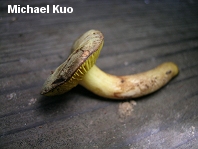| Major Groups > Gilled Mushrooms > Phylloporus & Phylloporopsis > Phylloporus arenicola |

|
Phylloporus arenicola [ Basidiomycota > Boletales > Boletaceae > Phylloporus . . . ] by Michael Kuo, 20 October 2025 Many years ago, in coastal California's Salt Point State Park, I was eagerly collecting a Cortinarius species that was growing everywhere (and which I have yet to identify, even to subgenus), when I noticed a little "gilled bolete" in sandy soil. Not a big deal, I thought, and casually flipped it into the woods. Later, at the Sonoma County Mycological Association Mushroom Camp's foray tables, I mentioned finding a stupid little Phylloporus to several local mushroom hunters—whose jaws dropped in disbelief. "The gilled bolete doesn't grow around here," I was told. I had not even taken a photo, so I had no evidence of my apparently rare find. Then someone else brought in a tiny gilled bolete and, as they say, the crowd went wild. It was the rare Phylloporus arenicola, a sand-loving Phylloporus known primarily from the Oregon coast but not, it turned out, completely unheard of in northern California. The lesson is: When you are far from home, don't assume the mushrooms are close to home. I was lucky to be able to photograph someone else's Phylloporus arenicola on a table, but I sure wish I had taken in situ photos of the one I found, and preserved the specimen for study later. That was on my first trip to northern California, now twenty years ago. I have since returned many times and made hundreds of much better-documented collections . . . but I have never seen Phylloporus arenicola again. Sigh. Description: Note: Because I did not actually collect the illustrated specimen (see above), much of the description below is based on the sources cited. Ecology: Mycorrhizal with pines, including lodgepole pine and bishop pine; usually growing alone in sandy coastal soil; winter; coastal Oregon and coastal northern California. Cap: 1.5–4.5 cm; broadly convex, becoming more or less flat, or shallowly depressed; dry; bald or finely velvety; olive to olive brown or yellowish brown. Gills: Attached to the stem but not running down it significantly, and often pulling away from it in age; distant or nearly so; thick; short-gills frequent; yellow to golden yellow; not usually bruising but occasionally bruising blue. Stem: 4–6 cm long; up to about 1 cm thick; tapered downward; yellowish, with reddish and brownish stains or hairs; basal mycelium yellow. Flesh: Pale yellow; not usually staining when exposed but sometimes bluing. Odor and Taste: Not distinctive. Chemical Reactions: Ammonia purple or red on cap surface. Iron salts weakly olive on flesh. Fleeting amyloid reaction positive for gill tissue. Spore Print: Olive brown. Microscopic Features: Spores 9–12 x 4–5 µm; subfusiform; hyaline to yellowish in KOH; brownish in Melzer's reagent. Hymenial cystidia 50–90 x 10–15 µm; subfusiform or lageniform; smooth; thin-walled. Pileipellis a trichoderm; elements cylindric, smooth or encrusted; hyaline to yellow in KOH; terminal cells with rounded apices; subterminal cells cylindric. Stipitipellis of parallel hyphae with occasional caulocystidia. Clamp connections not found. REFERENCES: Smith & Trappe, 1972. (Smith & Trappe, 1972; Bessette, Roody & Bessette, 2000; Kuo & Methven, 2010; Neves & Halling, 2010; Neves et al., 2012; Desjardin, Wood & Stevens, 2015; Siegel & Schwarz, 2016; Gutiérrez-Domínguez et al., 2024; Tremble et al., 2024.) This site contains no information about the edibility or toxicity of mushrooms. |
© MushroomExpert.Com |
|
Cite this page as: Kuo, M. (2025, October). Phylloporus arenicola. Retrieved from the MushroomExpert.Com Web site: http://www.mushroomexpert.com/phylloporus_arenicola.html |
